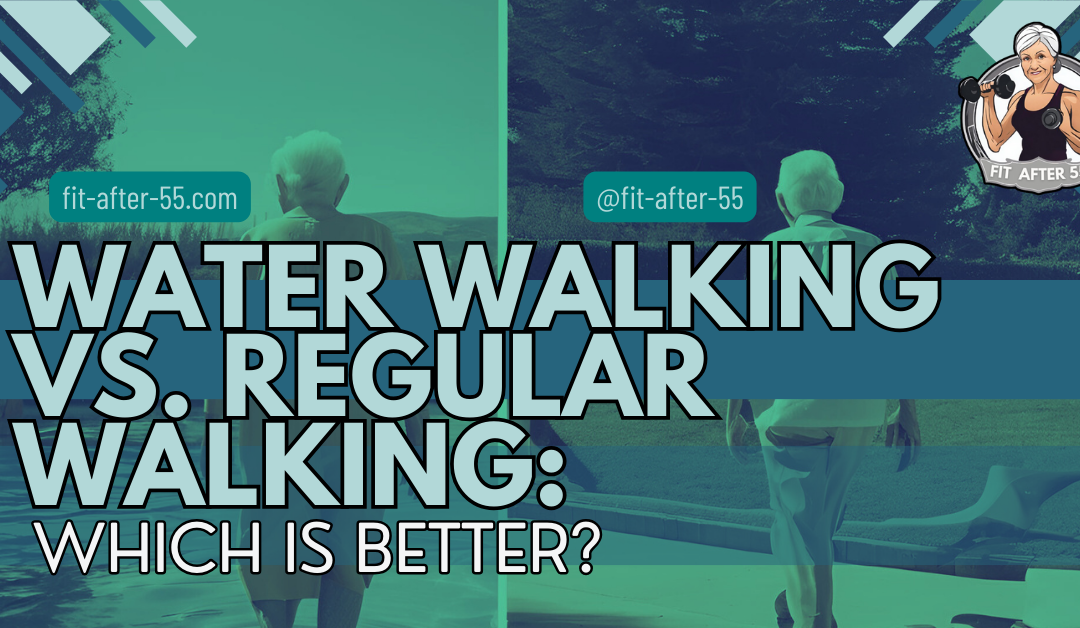For seniors and fitness-conscious individuals alike, choosing the right exercise can be pivotal in maintaining health and well-being. Today, the debate often centers around two popular forms of physical activity: water walking and regular walking.
Each offers unique benefits tailored to different needs and abilities. Whether you’re seeking low-impact options to ease joint pain or searching for effective cardiovascular workouts, understanding the differences between these exercises is crucial.
Join us as we explore the merits of both, helping you decide which path best suits your lifestyle and goals.
Water Walking vs. Regular Walking: Exploring Two Popular Forms of Physical Exercise
I’m going to kick things off by exploring the two popular forms of physical exercise: water walking and regular walking. If you’re wondering what sets them apart and which might suit you best, you’re not alone.

| Activity | Description |
|---|---|
| Water Walking | Water walking involves walking in water, typically in a pool. It’s a form of resistance training that’s caught the eye of fitness enthusiasts lately. |
| Regular Walking | Regular walking is as straightforward as it gets: walking on land, whether it’s strolling through your neighborhood or hiking a trail. |
| Aspect | Details |
|---|---|
| Historical Context | Regular walking has been a fundamental part of human mobility for millennia. |
| Water walking, on the other hand, is a structured fitness regimen that has gained popularity only in recent years. |
| Physical Differences | Details |
|---|---|
| Walking Environment | |
| Water Walking | Involves walking in water, typically in a pool. It’s a form of resistance training due to the water’s buoyancy and viscosity. |
| Regular Walking | Involves walking on land, whether it’s strolling through your neighborhood or hiking a trail. It primarily engages muscles and bones due to gravitational force. |
Snapshot of Benefits
So here’s a snapshot: the health and wellness community has been buzzing about the merits of both. From professional athletes to the everyday fitness seeker, many are incorporating these methods into their routines for a balanced approach to health. As we delve into the myriad benefits, you may start seeing why there’s so much enthusiasm about getting your feet moving – whether they’re splashing through water or pounding the pavement.

Key Takeaways:
Water Walking:
- Benefits: Low-impact, muscle strengthening, burns more calories.
- Considerations: Requires pool access, possible extra costs.
Regular Walking:
- Benefits: Convenient, improves mental health, reduces chronic disease risks.
- Considerations: Minimal equipment, weather-dependent outdoors.
Comparison:
- Fitness Goals: Water walking for muscle and calorie burn; regular walking for overall health.
- Age and Mobility: Water walking for seniors and joint issues; regular walking for all.

Benefits of Water Walking
Let’s kick things off by exploring the advantages of water walking. Imagine yourself in a pool; as you move against the water’s resistance, your muscles work harder than they would on land. This is the beauty of water walking – it’s a low-impact exercise, meaning it’s gentle on your joints, making it an ideal choice for those in the midst of injury recovery or for individuals experiencing chronic joint pain.

Muscle Strengthening Effectiveness
The resistance offered by water isn’t just easy on the body; it’s also remarkably effective for muscle strengthening. You’re going to find out about the science behind it – when you push against water, which is denser than air, your muscles have to exert more force. This resistance leads to a more intense workout, targeting multiple muscle groups concurrently.
Cardiovascular Fitness Benefits
Cardiovascular fitness gets a major boost as well. Moving through water requires more effort, thus prolonging the duration of your heart rate elevation during the exercise. This isn’t just about strengthening your heart; it’s also about improving circulation and increasing lung capacity, which can be particularly beneficial for those who may struggle with high-impact aerobic exercises.
Calorie Burning Potential
Now, what about the calorie burn? Walking in water can burn almost double the calories compared to walking the same distance on land. If weight loss is one of your objectives, this fact alone might steer you towards choosing water walking as a part of your exercise regimen.

Benefits of Regular Walking
You’re going to find out about the tremendous benefits that come with regular walking. This isn’t just about keeping your legs moving; it’s also about holistic health benefits that you can easily integrate into your daily routine. Let’s get into what makes regular walking a standout option for your wellness journey.

First up, it’s the ultimate convenience exercise. You don’t need a gym membership or any specific equipment. You can walk to work, take a brisk stroll in the park, or even pace around your home. This ease of access encourages consistency, and as you may well know, consistency is key to reaping long-term health benefits.
Mental health advantages also spring to mind. A walk is more than just physical exercise; it’s therapeutic. It allows you to clear your mind, soak in your surroundings, and can act as a meditative practice to relieve stress and elevate your mood. Regular exposure to outdoor walking could even bolster your Vitamin D levels if the sun’s out!

Speaking of health, did you know that walking regularly can lower your risk of chronic conditions like heart disease, stroke, and diabetes? And let’s not forget weight management. While it may not burn calories at the same rate as water walking, regular walking still contributes to a calorie deficit which can help in maintaining or losing weight over time.
Moving forward, consider how such a simple activity, when done regularly, can positively influence not only your physical but also your mental well-being. And you don’t have to overdo it; a quick 30-minute walk five days a week is often enough to start seeing changes in your fitness levels.
So with these benefits in mind, you might wonder how regular walking stacks up against water walking when considering your age, abilities, and fitness goals. That’s exactly what we’re going to explore in the next section.
Comparing the Suitability for Different Ages and Abilities
When it comes to exercise, one size doesn’t fit all. Both water walking and regular walking offer unique benefits, but how do you decide which is more suitable for you or someone you care for? It’s about matching the activity to the individual’s age, fitness level, and health condition.

| For Younger, More Active Individuals | For Seniors and Individuals with Limited Mobility |
|---|---|
| Regular walking might be the go-to exercise. It’s fast, flexible, and can be turned into a high-energy workout with just a few brisk pace adjustments. | Water walking can immensely benefit seniors. The buoyancy of water reduces stress on weight-bearing joints, making it safe for arthritis or balance issues. |
| The water’s resistance helps maintain or build muscle mass and strength, essential for older adults. |
| For Children and Individuals with Disabilities | For Those in the Middle Stage of Life |
|---|---|
| Regular walking encourages physical activity and can be part of playtime or a structured routine. | Both forms of walking fit into your hectic schedule. A quick 30-minute walk around the block after dinner or a water walking session at the local pool during a lunch break can do wonders for your stress levels and health. |
The key is to choose something that resonates with you and aligns with your lifestyle. Remember, you can always adjust your approach down the road if your circumstances change or if you simply want to mix things up a bit.

Practical Considerations and Limitations
You’re going to find out about the practical aspects that impact your choice between water walking and regular walking. It isn’t just about the fitness benefits; factors like accessibility play a huge role.

Consider first the availability of swimming pools or natural water bodies. Not everyone has easy access to a pool, and this can be a significant barrier to water walking. Furthermore, you might need to consider the costs, such as pool memberships or even travel expenses to reach a suitable location.
Now what about the weather? Regular walking is subject to the whims of Mother Nature, meaning a rainy day or a harsh winter could disrupt your routine. On the flip side, water walking indoors can be a year-round activity, though outdoor water environments are also weather-dependent.

Don’t worry too much about equipment, but keep in mind that regular walking generally requires less gear. A good pair of shoes and appropriate clothing are the main items. Water walking might require swimwear, water shoes, and possibly access to flotation devices if needed.
Time is another factor. Perhaps you can squeeze in a walk during your lunch break, but do you have time to travel to and from a pool, change into swimwear, and shower afterwards? It’s important to factor in the time investment for water walking as opposed to slipping on your shoes and stepping outside.
You can always adjust your approach down the road, but these practical considerations could significantly shape your initial choice. That’s why in the next section, I’ll be helping you weigh these factors against your personal needs, to make an informed decision that’s best for you.
Making an Informed Choice Between Water Walking and Regular Walking
Now you’re armed with the essentials about both water walking and regular walking. Remember, choosing between them isn’t just a matter of picking the ‘better’ option; it’s about finding what fits your lifestyle, goals, and enjoyment.
If you’re focusing on rehab or you have joint issues, water walking might feel like a blessing. On the other hand, if you love the simplicity of strapping on your sneakers and stepping out the door, regular walking is incredibly straightforward and beneficial.

Don’t rely solely on what you read or hear — consult with a healthcare or fitness professional to get advice tailored specifically to you. They can consider factors that articles can’t cover, like individual health conditions and personal history.
I encourage you to give both a try. A week of regular walking and a couple of sessions in the pool might reveal a clear favorite, or you might find a blend works best. It’s not set in stone, and you can always adjust based on what your body tells you.
In the end, the best exercise for you is the one you’ll do consistently. Whether you choose water walking, regular walking, or a combination of both, commit to moving regularly. Your body and mind will thank you for it.
Conclusion: Choosing the Right Exercise for You
In closing, both water walking and regular walking offer unique benefits for maintaining a healthy lifestyle, especially for seniors and fitness enthusiasts.


Water walking provides gentle resistance training that’s kind to joints and effective for muscle strengthening and calorie burning. Meanwhile, regular walking offers simplicity, convenience, and significant mental health benefits, making it accessible to all.
Whether you’re recovering from injury, managing chronic conditions, or aiming for overall fitness, choose the exercise that best fits your lifestyle and goals. Consult with a healthcare or fitness professional to tailor your plan.
Remember, the key to reaping the benefits lies in consistency. Whether you prefer the gentle resistance of water or the simplicity of a stroll, start today and keep moving toward a healthier you!
Take the next step – choose your exercise and start moving today!
FAQs about Water Walking and Regular Walking
What are the main differences between water walking and regular walking?
Water walking involves walking in a pool, providing resistance training that’s gentle on joints. Regular walking is done on land, offering convenience and mental health benefits like stress reduction.
Which is better for seniors: water walking or regular walking?
Both exercises have benefits for seniors. Water walking is gentle on joints and helps build strength. Regular walking improves cardiovascular health and mental well-being.
Can water walking help with weight loss?
Yes, water walking can burn almost double the calories compared to regular walking due to increased resistance from water.
How often should I do water walking or regular walking for optimal health benefits?
Aim for at least 30 minutes of walking, five days a week. Choose the exercise that fits best with your lifestyle and health goals.
Explore Senior Fitness with Us!
Visit our official website Fit After 55 and connect with us on Facebook for engaging content, product reviews, and a community dedicated to senior fitness. Join us in staying active and healthy together!

